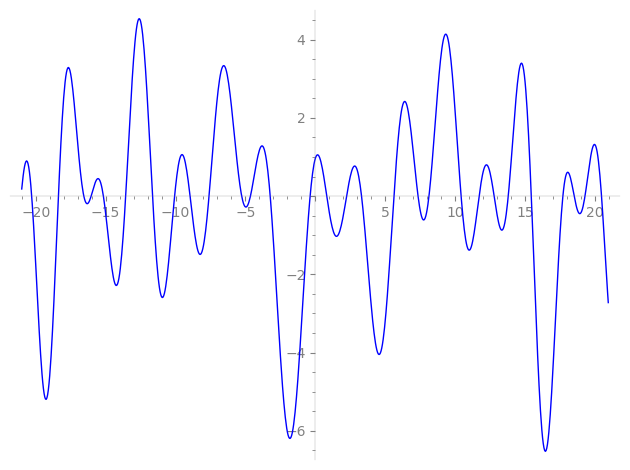| L(s) = 1 | + 8.19e3i·2-s + 4.36e6i·3-s − 6.71e7·4-s + (−1.84e9 − 2.01e9i)5-s − 3.57e10·6-s − 1.94e10i·7-s − 5.49e11i·8-s − 1.13e13·9-s + (1.65e13 − 1.50e13i)10-s − 1.73e14·11-s − 2.92e14i·12-s + 6.75e14i·13-s + 1.58e14·14-s + (8.78e15 − 8.03e15i)15-s + 4.50e15·16-s − 4.72e16i·17-s + ⋯ |
| L(s) = 1 | + 0.707i·2-s + 1.57i·3-s − 0.5·4-s + (−0.674 − 0.738i)5-s − 1.11·6-s − 0.0756i·7-s − 0.353i·8-s − 1.49·9-s + (0.521 − 0.477i)10-s − 1.51·11-s − 0.789i·12-s + 0.618i·13-s + 0.0535·14-s + (1.16 − 1.06i)15-s + 0.250·16-s − 1.15i·17-s + ⋯ |
\[\begin{aligned}\Lambda(s)=\mathstrut & 10 ^{s/2} \, \Gamma_{\C}(s) \, L(s)\cr =\mathstrut & (0.738 - 0.674i)\, \overline{\Lambda}(28-s) \end{aligned}\]
\[\begin{aligned}\Lambda(s)=\mathstrut & 10 ^{s/2} \, \Gamma_{\C}(s+27/2) \, L(s)\cr =\mathstrut & (0.738 - 0.674i)\, \overline{\Lambda}(1-s) \end{aligned}\]
Particular Values
| \(L(14)\) |
\(\approx\) |
\(0.9640192552\) |
| \(L(\frac12)\) |
\(\approx\) |
\(0.9640192552\) |
| \(L(\frac{29}{2})\) |
|
not available |
| \(L(1)\) |
|
not available |
\(L(s) = \displaystyle \prod_{p} F_p(p^{-s})^{-1} \)
| $p$ | $F_p(T)$ |
|---|
| bad | 2 | \( 1 - 8.19e3iT \) |
| 5 | \( 1 + (1.84e9 + 2.01e9i)T \) |
| good | 3 | \( 1 - 4.36e6iT - 7.62e12T^{2} \) |
| 7 | \( 1 + 1.94e10iT - 6.57e22T^{2} \) |
| 11 | \( 1 + 1.73e14T + 1.31e28T^{2} \) |
| 13 | \( 1 - 6.75e14iT - 1.19e30T^{2} \) |
| 17 | \( 1 + 4.72e16iT - 1.66e33T^{2} \) |
| 19 | \( 1 - 2.99e17T + 3.36e34T^{2} \) |
| 23 | \( 1 + 1.42e18iT - 5.84e36T^{2} \) |
| 29 | \( 1 + 4.14e19T + 3.05e39T^{2} \) |
| 31 | \( 1 - 1.01e20T + 1.84e40T^{2} \) |
| 37 | \( 1 - 4.31e20iT - 2.19e42T^{2} \) |
| 41 | \( 1 + 6.35e21T + 3.50e43T^{2} \) |
| 43 | \( 1 - 1.92e22iT - 1.26e44T^{2} \) |
| 47 | \( 1 + 6.41e22iT - 1.40e45T^{2} \) |
| 53 | \( 1 - 7.01e22iT - 3.59e46T^{2} \) |
| 59 | \( 1 - 7.97e23T + 6.50e47T^{2} \) |
| 61 | \( 1 + 7.03e23T + 1.59e48T^{2} \) |
| 67 | \( 1 + 1.48e24iT - 2.01e49T^{2} \) |
| 71 | \( 1 + 1.17e25T + 9.63e49T^{2} \) |
| 73 | \( 1 + 1.70e25iT - 2.04e50T^{2} \) |
| 79 | \( 1 - 6.04e25T + 1.72e51T^{2} \) |
| 83 | \( 1 + 8.94e25iT - 6.53e51T^{2} \) |
| 89 | \( 1 - 1.26e26T + 4.30e52T^{2} \) |
| 97 | \( 1 + 1.36e26iT - 4.39e53T^{2} \) |
| show more | |
| show less | |
\(L(s) = \displaystyle\prod_p \ \prod_{j=1}^{2} (1 - \alpha_{j,p}\, p^{-s})^{-1}\)
Imaginary part of the first few zeros on the critical line
−15.16057025983889407305926013722, −13.56650267054689121960964277922, −11.64418586186126355682387407628, −10.06598039871587312118162614507, −8.960212380414531591120623518471, −7.60472975116644408249653241317, −5.26802038706227717058760235673, −4.64222500405085291851038411746, −3.22926972852824174784581066506, −0.37353352445383841770563745480,
0.816525511189537695657535373455, 2.23678799468827393266342888808, 3.30331909322200265722057027099, 5.61960410182131025739192401234, 7.34531911590250015241262320453, 8.126292170803869773170570245201, 10.42537442071668259955705073414, 11.71288723087704321374940910386, 12.78624932422060798698597775363, 13.79582496857389457000093509023

